

A teacher's guide to instagram (note) A teachers guide to instagram - Middle School Minds. TEACHINGBLOG (Note) TEACHINGBLOG - Mrs. Byars - History Teacher. Students Speak Up (note) Students Speak Up in Class, Silently, via Social Media. “When we have class discussions, I don’t really feel the need to speak up or anything,” said one of her students, Justin Lansink, 17.
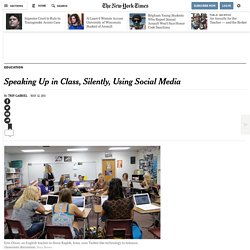
“When you type something down, it’s a lot easier to say what I feel.” With Twitter and other microblogging platforms, teachers from elementary schools to universities are setting up what is known as a “backchannel” in their classes. The real-time digital streams allow students to comment, pose questions (answered either by one another or the teacher) and shed inhibitions about voicing opinions. Blogging in the 2st Century Classroom (note) Blogging in the 21st-Century Classroom. This year, I admitted a hard truth to myself.
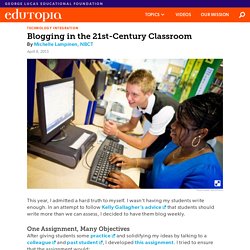
I wasn't having my students write enough. In an attempt to follow Kelly Gallagher’s advice that students should write more than we can assess, I decided to have them blog weekly. One Assignment, Many Objectives After giving students some practice and solidifying my ideas by talking to a colleague and past student, I developed this assignment. I tried to ensure that the assignment would: Address multiple Common Core standards Hold students accountable while minimizing stress Be structured enough to provide clarity while giving freedom to experiment Be varied enough to keep students engaged Get students to write for multiple purposes I introduced blogging to my juniors, reminding them to keep an open mind about this experiment (they could relate to that; I teach in a STEM school that focuses on life science and experimental research).
It. Skill and Enthusiasm First and foremost, student writing is improving by leaps and bounds. Less Agonizing Pain. Participatory Learning (note) Participatory Learning Through Social Media: How and Why Social Studies Educators Use Twitter – CITE Journal. Scholars have long bemoaned the failure of educational institutions to transform pedagogy through the use of new technologies (Cuban, 1986, 2001; Oppenheimer, 1997), and the field of social studies has not escaped such scrutiny (Berson, Lee, & Stuckart, 2001; Diem, 2008; Stoddard, 2010; Swan & Hofer, 2008).

Seventeen years ago, Martorella (1997) called technology the “sleeping giant” of the social studies because “technology issues appear to have a low priority for social studies educators” who must help students deliberate upon the social upshots of technological trends (p. 512). 7 Ways (note) 7 Ways Teachers Use Social Media in the Classroom. Millennials live and breathe on social media, so teachers are learning how to incorporate the medium into the classroom successfully.
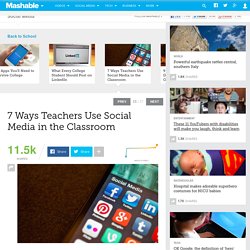
In doing so, teachers not only encourage students to engage actively in the material, but they also provide online communities for students that might not exist for them in real life. But how are teachers infusing social media into their everyday lessons? We've highlighted several different examples and offered our own ideas on how to best engage students. 1. Using Social Media (note) Using Social Media as a Teaching Tool. Teaching Social Media as a tool is imperative in todays day and age.
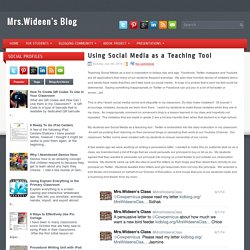
Facebook, Twitter, Instagram and Youtube are all applications that many of our students frequent everyday. We also hear horrible stories of mistakes teens and adults have made that they can't take back on social media. Social Media for Science Outreach (note) Social Media for Science Outreach – A Case Study: Upper-level biology students blog about their independent research projects. To tie in with this month’s SoNYC birthday celebrations, we are hosting a collection of case studies that discuss how social media can be used for science outreach.
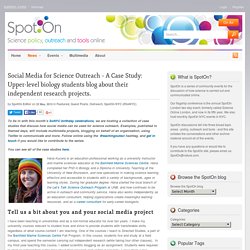
Examples, published in themed days, will include multimedia projects, blogging on behalf of an organisation, using Twitter to communicate and more. Follow online using the #reachingoutsci hashtag, and get in touch if you would like to contribute to the series. !0 Cool Ways (note) 10 Cool Ways Teachers Use Social Media to Enhance Learning. Doing work that matters.

All students should be able to be part of that. No longer working for the teacher’s wastebasket, students across the world are connecting and sharing like never before. They are led by teachers unafraid of the world but who escort their kids out to meet the future. While a recent poll showed 9 out of 10 teachers do not use social media in the classroom, there are teachers who are. Social doesn’t have to be a distraction and kids can be safe. This question is part of CM Rubin World’s question of the month, “What are the best examples you have seen of teachers using social media to enhance learning?”
1. Aussie teacher Jacques du Toit has his students create Twitter accounts as many of the well known Aztecs. 2. Using a Twitter account, @MrsLsClass, Karen Lirenman and her class share their work with the world. 3. Kathy Cassidy’s classroom blog is an endearing example of when students are allowed to blog and share their work. 4. 5. 6. 7. 8. 9. 10. Success! #Organellewars (note) #OrganelleWars: A Model for Using Social Media in the Science Classroom. Given the current political fervor over the candidacies of the people attempting to become our next president, now seemed like a good time to revisit one of the most successful projects I have had the good fortune of incorporating into my freshman biology classroom.

Launching a Model Organelle Campaign In the fall of 2011, I had reached the point of the school year when it was time to start teaching my freshman biology students about the cell and its organelles. In my 14 years of teaching to that point, I had tried all types of different approaches to try and bring the cell alive for my students. I had tried direct instruction, having students build models of the cell, asking them to make analogies comparing the cell to a city, having them give presentations on individual organelles, even putting on a pretend radio show in class, and finally making fake Facebook pages on paper for each organelle. Moderate Success in Year One The first year of the project went pretty well.
Think Bigger About Science (note) "Think bigger about science": Using Twitter for learning in the middle grades. Introduction Middle level educators have a deep awareness of their students' tremendously social nature.

Young adolescents yearn to be connected with their peers, whether sharing excitedly during lunch, on the school bus, or in the hall- ways, and regardless of whether they are face-to-face, across a room, or immersed in a screen. Digital tools, including social media, now enable these interactions at an almost ubiquitous level, both in and out of school.